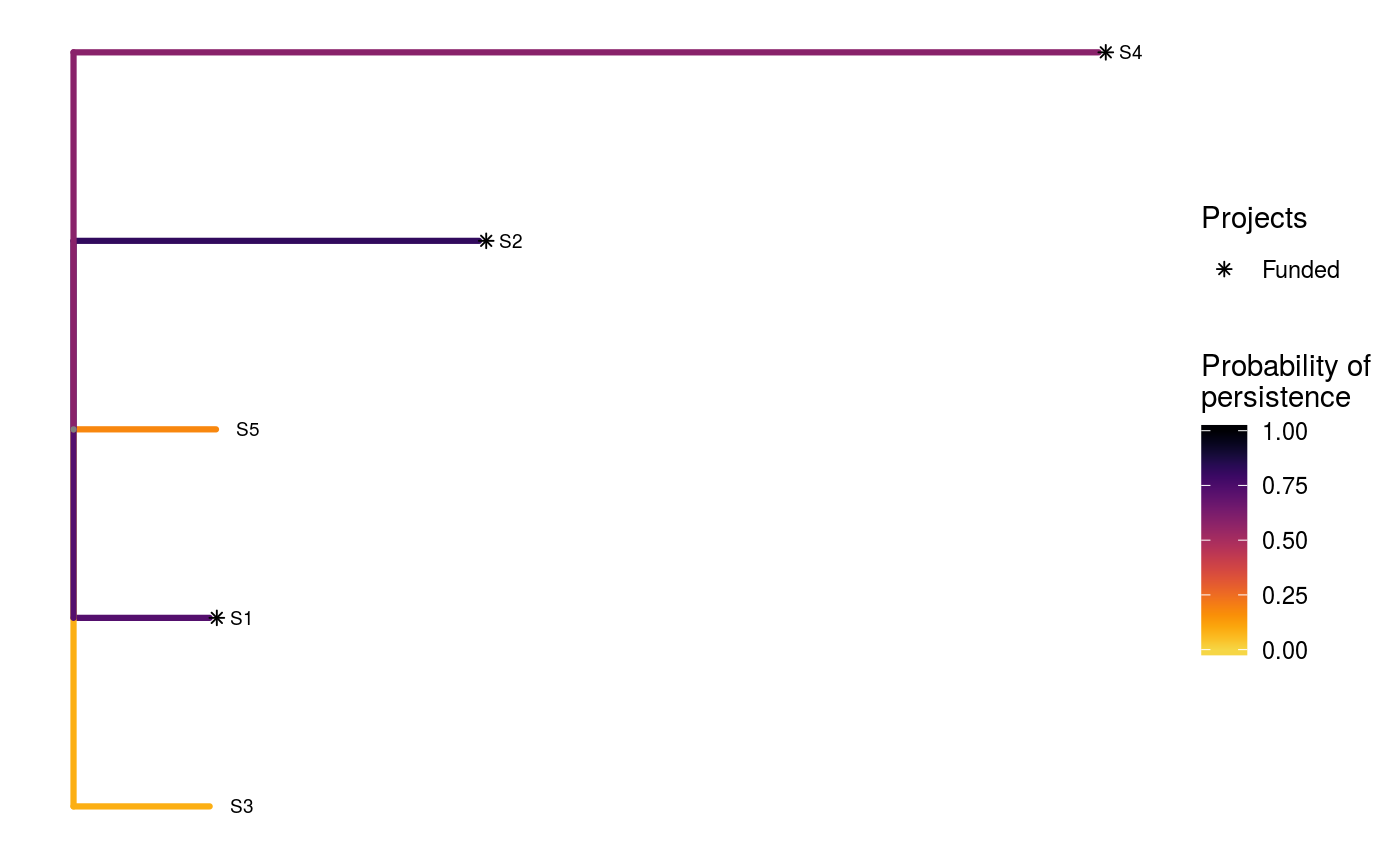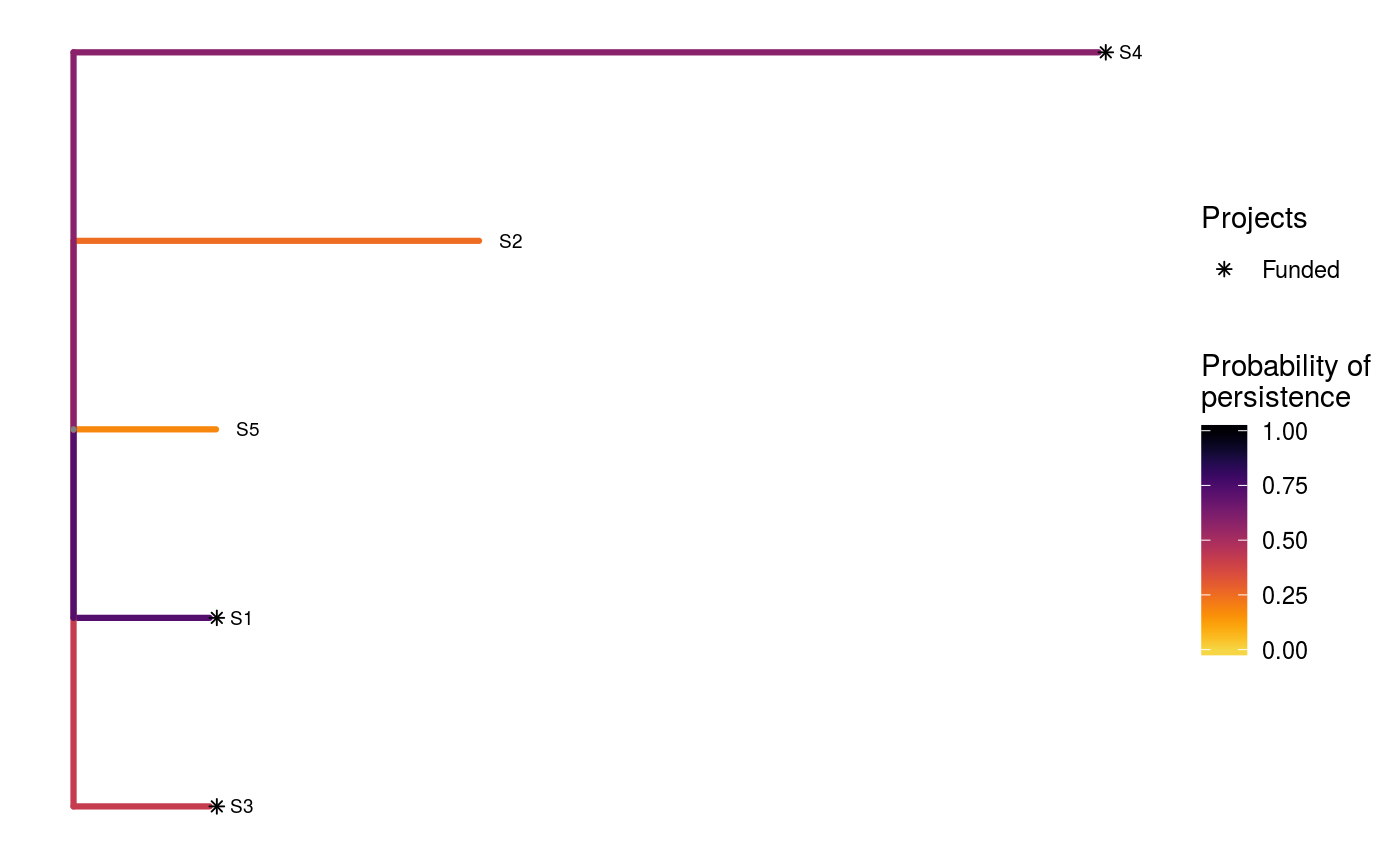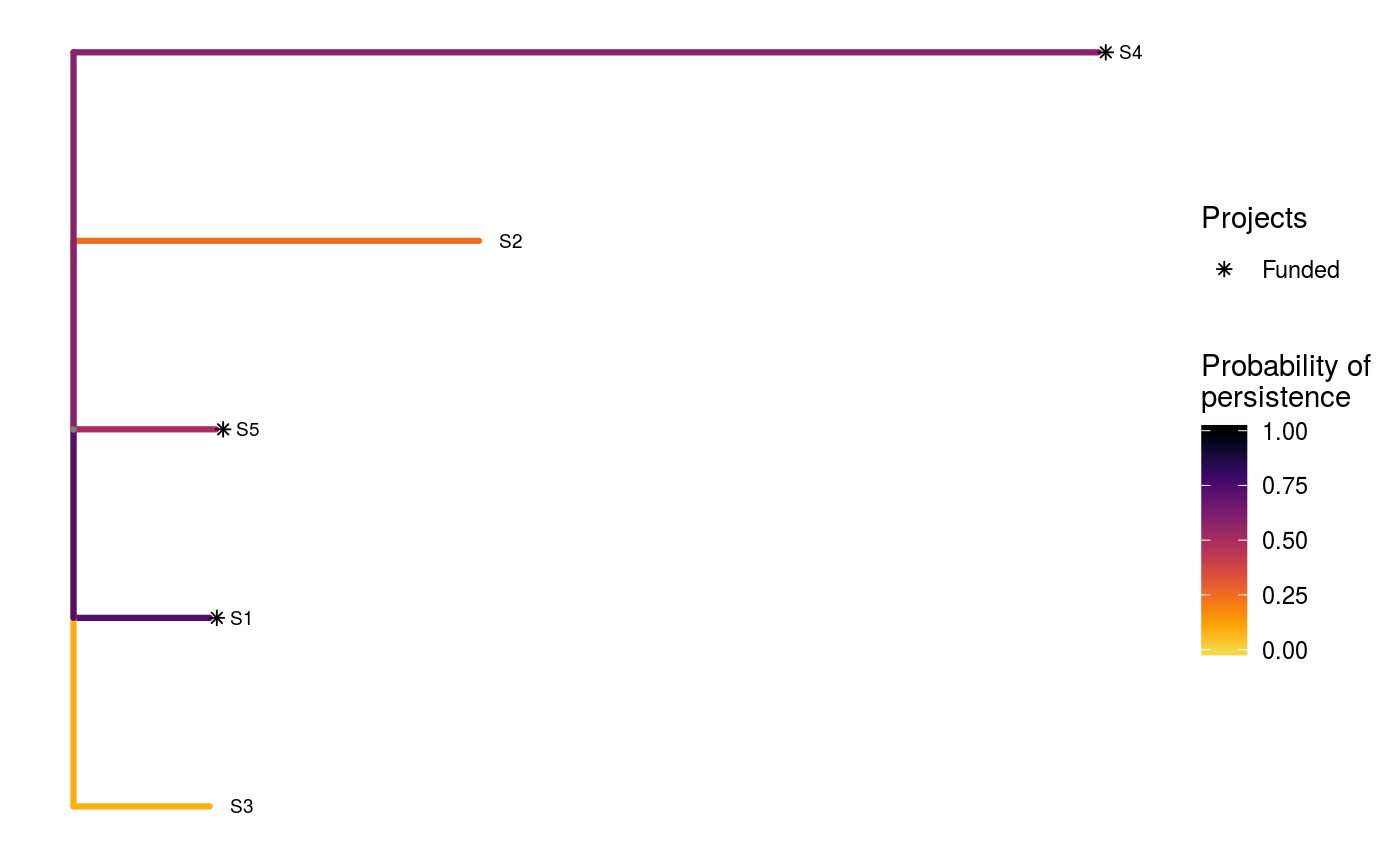Prioritize conservation projects by maximizing expected weighted species richness using exact algorithms
Source:R/ppp_exact_spp_solution.R
ppp_exact_spp_solution.RdPrioritize funding for conservation projects with species weights and using exact algorithms. Unlike other algorithms for solving the 'Project Prioritization Protocol' (Joseph, Maloney & Possingham 2009), this method can identify solutions that are guaranteed to be optimal (or within a pre-specified optimality gap; see Underhill 1994; Rodrigues & Gaston 2002). As a consequence, it is strongly recommended to use this method for developing project prioritizations.
ppp_exact_spp_solution(x, y, spp, budget, project_column_name, success_column_name, action_column_name, cost_column_name, species_column_name, weight_column_name, locked_in_column_name = NULL, locked_out_column_name = NULL, gap = 1e-06, threads = 1L, number_solutions = 1L, time_limit = .Machine$integer.max, number_approx_points = 300, verbose = FALSE)
Arguments
| x |
|
|---|---|
| y |
|
| spp |
|
| budget |
|
| project_column_name |
|
| success_column_name |
|
| action_column_name |
|
| cost_column_name |
|
| species_column_name |
|
| weight_column_name |
|
| locked_in_column_name |
|
| locked_out_column_name |
|
| gap |
|
| threads |
|
| number_solutions |
|
| time_limit |
|
| number_approx_points |
|
| verbose |
|
Value
A tibble object containing the
solution(s) data. Each row corresponds to a different solution, and
each column describes a different property of the solution. The object
contains a column for each project (based on the argument to
project_column_name) which contains logical values indicating
if the project was prioritized for funded (TRUE) or not
(FALSE) in a given solution. Additionally, the object also contains
the following columns:
"solution"integersolution identifier."method"charactername of method used to produce the solution(s).)"budget"numericbudget used for generating each of the of the solution(s)."obj"numericobjective value. If phylogenetic data were input, then this column contains the expected phylogenetic diversity (Faith 2008) associated with each of the solutions. Otherwise, this column contains the expected weighted species richness (i.e. the sum of the product between the species' persistence probabilities and their weights."cost"numerictotal cost associated with each of of the solution(s)."optimal"logicalindicating if each of the solution(s) is known to be optimal (TRUE) or not (FALSE). Missing values (NA) indicate that optimality is unknown (i.e. because the method used to produce the solution(s) does not provide any bounds on their quality).
Details
This function works by formulating the 'Project Prioritization Protocol' as a mixed integer programming problem (MIP) and solving it using the Gurobi optimization software suite. Although Gurobi is a commercial software, academics can obtain a special license for no cost. After downloading and installing the hrefhttps://www.gurobi.comGurobi software suite, the gurobi package will also need to be installed (see instructions for Linux, Mac OSX, and Windows operating systems). Finally, the gurobi package will also need to be installed (see instructions for Linux, Mac OSX, and Windows operating systems).
This problem aims to maximize expected species weighted richness given
a budget. Let \(S\) denote the set of species (indexed by
\(s\)), and let \(W_s\) denote the weight for each species.
Additionally, let E_s denote the probability that each species
will go extinct given the funded conservation projects. The objective
can be expressed as:
$$
\sum_{s}^{S} (1 - E_s) W_s
$$
For the complete mathematical formulation, please refer to the formulation
for maximizing expected phylogenetic diversity (i.e.
ppp_exact_phylo_solution). This is because maximizing
expected weighted species richness is merely a special-case of
expected phylogenetic diversity---instead of using a complete phylogeny,
expected weighted species richness simply uses a star phylogeny with
branch lengths set according to the species' weights.
References
Faith DP (2008) Threatened species and the potential loss of phylogenetic diversity: conservation scenarios based on estimated extinction probabilities and phylogenetic risk analysis. Conservation Biology, 22: 1461--1470.
Joseph LN, Maloney RF & Possingham HP (2009) Optimal allocation of resources among threatened species: A project prioritization protocol. Conservation Biology, 23, 328--338.
Rodrigues AS & Gaston KJ (2002) Optimisation in reserve selection procedures---why not? Biological Conservation, 107: 123-129.
Underhill LG (1994) Optimal and suboptimal reserve selection algorithms. Biological Conservation, 70: 85--87.
See also
For other methods for solving the 'Project Prioritization Protocol'
problem, see ppp_heuristic_phylo_solution,
ppp_manual_phylo_solution, and
ppp_random_phylo_solution.
To visualize the effectiveness of a particular solution, see
ppp_plot_phylo_solution.
Examples
# load built-in data data(sim_project_data, sim_action_data, sim_species_data) # print simulated project data set print(sim_project_data)#> # A tibble: 6 x 13 #> name success S1 S2 S3 S4 S5 S1_action S2_action S3_action #> <chr> <dbl> <dbl> <dbl> <dbl> <dbl> <dbl> <lgl> <lgl> <lgl> #> 1 S1_p~ 0.919 0.791 0 0 0 0 TRUE FALSE FALSE #> 2 S2_p~ 0.923 0 0.888 0 0 0 FALSE TRUE FALSE #> 3 S3_p~ 0.829 0 0 0.502 0 0 FALSE FALSE TRUE #> 4 S4_p~ 0.848 0 0 0 0.690 0 FALSE FALSE FALSE #> 5 S5_p~ 0.814 0 0 0 0 0.617 FALSE FALSE FALSE #> 6 base~ 1 0.298 0.250 0.0865 0.249 0.182 FALSE FALSE FALSE #> # ... with 3 more variables: S4_action <lgl>, S5_action <lgl>, #> # baseline_action <lgl>#> # A tibble: 6 x 4 #> name cost locked_in locked_out #> <chr> <dbl> <lgl> <lgl> #> 1 S1_action 94.4 FALSE FALSE #> 2 S2_action 101. FALSE FALSE #> 3 S3_action 103. TRUE FALSE #> 4 S4_action 99.2 FALSE FALSE #> 5 S5_action 99.9 FALSE TRUE #> 6 baseline_action 0 FALSE FALSE#> # A tibble: 5 x 2 #> name weight #> <chr> <dbl> #> 1 S3 0.211 #> 2 S1 0.211 #> 3 S5 0.221 #> 4 S2 0.630 #> 5 S4 1.59# verify if guorbi package is installed if (!require(gurobi, quietly = TRUE)) stop("the gurobi R package is not installed.") # find a solution that meets a budget of 300 s1 <- ppp_exact_spp_solution(sim_project_data, sim_action_data, sim_species_data, 300, "name", "success", "name", "cost", "name", "weight") # print solution print(s1)#> # A tibble: 1 x 12 #> solution method obj budget cost optimal S1_action S2_action S3_action #> <int> <chr> <dbl> <dbl> <dbl> <lgl> <lgl> <lgl> <lgl> #> 1 1 exact 1.66 300 295. TRUE TRUE TRUE FALSE #> # ... with 3 more variables: S4_action <lgl>, S5_action <lgl>, #> # baseline_action <lgl># plot solution ppp_plot_spp_solution(sim_project_data, sim_action_data, sim_species_data, s1, "name", "success", "name", "cost", "name", "weight")# find a solution that meets a budget of 300 and allocates # funding for the "S3_action" project. For instance, species "S3" might # be an iconic species that has cultural and economic importance. sim_action_data2 <- sim_action_data sim_action_data2$locked_in <- sim_action_data2$name == "S3_action" s2 <- ppp_exact_spp_solution(sim_project_data, sim_action_data2, sim_species_data, 300, "name", "success", "name", "cost", "name", "weight", locked_in_column_name = "locked_in") # print solution print(s2)#> # A tibble: 1 x 12 #> solution method obj budget cost optimal S1_action S2_action S3_action #> <int> <chr> <dbl> <dbl> <dbl> <lgl> <lgl> <lgl> <lgl> #> 1 1 exact 1.37 300 297. TRUE TRUE FALSE TRUE #> # ... with 3 more variables: S4_action <lgl>, S5_action <lgl>, #> # baseline_action <lgl># plot solution ppp_plot_spp_solution(sim_project_data, sim_action_data2, sim_species_data, s2, "name", "success", "name", "cost", "name", "weight")# find a solution that meets a budget of 300 and does not allocate # funding for the "S2_action" project. For instance, species "S2" # might have very little cultural or economic importance. Broadly speaking, # though, it is better to "lock in" "important" species rather than # "lock out" unimportant species. sim_action_data3 <- sim_action_data sim_action_data3$locked_out <- sim_action_data3$name == "S2_action" s3 <- ppp_exact_spp_solution(sim_project_data, sim_action_data3, sim_species_data, 300, "name", "success", "name", "cost", "name", "weight", locked_out_column_name = "locked_out") # print solution print(s3)#> # A tibble: 1 x 12 #> solution method obj budget cost optimal S1_action S2_action S3_action #> <int> <chr> <dbl> <dbl> <dbl> <lgl> <lgl> <lgl> <lgl> #> 1 1 exact 1.37 300 294. TRUE TRUE FALSE FALSE #> # ... with 3 more variables: S4_action <lgl>, S5_action <lgl>, #> # baseline_action <lgl># plot solution ppp_plot_spp_solution(sim_project_data, sim_action_data3, sim_species_data, s3, "name", "success", "name", "cost", "name", "weight")# find the top solutions s4 <- ppp_exact_spp_solution(sim_project_data, sim_action_data, sim_species_data, 300, "name", "success", "name", "cost", "name", "weight", number_solutions = 1000)#> Warning: although 1000 requested, only 18 solutions exist.#> # A tibble: 18 x 12 #> solution method obj budget cost optimal S1_action S2_action S3_action #> <int> <chr> <dbl> <dbl> <dbl> <lgl> <lgl> <lgl> <lgl> #> 1 1 exact 1.66 300 295. TRUE TRUE TRUE FALSE #> 2 2 exact 1.60 300 295. FALSE TRUE TRUE FALSE #> 3 3 exact 1.57 300 200. FALSE FALSE TRUE FALSE #> 4 4 exact 1.45 300 200. FALSE FALSE TRUE FALSE #> 5 5 exact 1.37 300 294. FALSE TRUE FALSE FALSE #> 6 6 exact 1.37 300 297. FALSE TRUE FALSE TRUE #> 7 7 exact 1.30 300 194. FALSE TRUE FALSE FALSE #> 8 8 exact 1.28 300 199. FALSE FALSE FALSE FALSE #> 9 9 exact 1.28 300 202. FALSE FALSE FALSE TRUE #> 10 10 exact 1.21 300 99.2 FALSE FALSE FALSE FALSE #> 11 11 exact 1.20 300 294. FALSE TRUE FALSE FALSE #> 12 12 exact 1.20 300 295. FALSE TRUE TRUE FALSE #> 13 13 exact 1.19 300 299. FALSE TRUE TRUE TRUE #> 14 14 exact 1.17 300 297. FALSE TRUE FALSE TRUE #> 15 15 exact 1.12 300 195. FALSE TRUE TRUE FALSE #> 16 16 exact 1.10 300 201. FALSE FALSE TRUE FALSE #> 17 17 exact 1.10 300 204. FALSE FALSE TRUE TRUE #> 18 18 exact 1.08 300 194. FALSE TRUE FALSE FALSE #> # ... with 3 more variables: S4_action <lgl>, S5_action <lgl>, #> # baseline_action <lgl>


